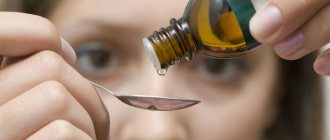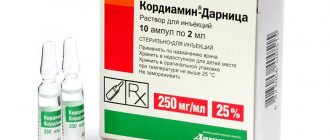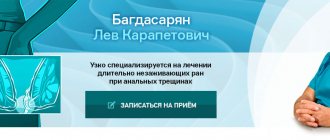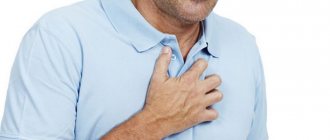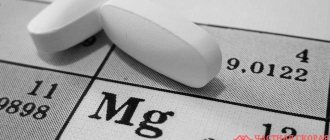Nosological classification (ICD-10)
- G90.9 Autonomic nervous system disorder, unspecified
- K29.6.1* Hyperacid gastritis
- K31.3 Pylorospasm, not elsewhere classified
- K80.5 Bile duct stones without cholangitis or cholecystitis
- K81.1 Chronic cholecystitis
- K82.8.0* Dyskinesia of the gallbladder and biliary tract
- N23 Renal colic, unspecified
- R10.4 Other and unspecified abdominal pain
- R45.1 Restlessness and agitation
Zelenin drops: indications
The drug is mainly used to treat diseases of the digestive and nervous systems:
- VSD;
- spasms of the gastrointestinal tract;
- increased nervous excitability;
- gastritis with high acidity;
- bile duct dyskinesia;
- chronic cholecystitis;
- hepatic, renal colic.
Zelenin drops are also used to treat certain pathologies of the cardiovascular system, for example, with cardioneurosis accompanied by bradycardia.
Pharmacodynamics
Belladonna leaf has an anticholinergic and antispasmodic effect. Interferes with the stimulating effect of acetylcholine; reduces the secretion of salivary, gastric, bronchial, lacrimal, sweat glands, pancreas. Reduces the tone of the muscles of the gastrointestinal tract, bile ducts and gallbladder; causes tachycardia, improves AV conduction. Dilates the pupils, impedes the outflow of intraocular fluid, increases intraocular pressure, and causes paralysis of accommodation.
Lily of the valley tincture has a cardiotonic effect.
Valerian rhizome with roots has a sedative and antispasmodic effect. Facilitates the onset of natural sleep. The sedative effect occurs slowly, but is quite stable.
Menthol is a local irritant, has a venotonic, analgesic, reflex coronary dilation and antianginal effect.
Contraindications and side effects
In some cases, taking the drug is excluded:
- individual intolerance to any component of the drug;
- allergic reactions;
- angle-closure glaucoma;
- prostate in a hypertrophied form, in which problems with urination are observed;
- myocarditis;
- cardiosclerosis;
- vascular atherosclerosis in an advanced stage;
- endocarditis.
With long-term use, dosage violation and in case of individual intolerance, the following side effects are possible:
- gastralgia;
- myasthenia gravis;
- feeling of nausea;
- arrhythmia;
- headaches;
- vomit;
- allergic reactions;
- increased drowsiness.
special instructions
The drug should be taken with caution by drivers and operators of moving machinery. Drops may reduce concentration and attention. Therapy is carried out with caution in children (up to 12 years) and the elderly. To enhance the therapeutic effect, Zelenin drops are sometimes combined with hawthorn-based drugs (must be agreed with your doctor).
During pregnancy and breastfeeding, the drug is used with caution and only in consultation with a doctor. Drops can only be used in cases where the expected benefits are higher than the potential risks.
Bradycardia. Real danger?
Bradycardia is a slowing of the heart rate (HR) due to decreased sinus node function. With bradycardia, the cells of the first order pacemaker, the sinus node, are affected.
The causes of bradycardia may be an imbalance with increased activity of the parasympathetic autonomic nervous system and organic irreversible damage to the heart.
The pacemaker cells of the sinus node produce 60–80 impulses per minute. The lower limit of the normal frequency of sinus rhythm is considered to be 60 per minute. Nearly 25% of healthy young men have a resting heart rate between 50 and 60 bpm. A decrease in heart rate to values less than 15% serves as another criterion for bradycardia.
Bradycardia is divided according to clinical and pathogenetic principles.
Classification of bradycardia:
- neurogenic (vagal);
- endocrine;
- toxic;
- medicinal;
- myogenic (organic);
- constitutional-family.
The neurogenic (vagal) form is represented by various variants and accompanies: neuroses with vagotonia, vagoinsular crises, increased intracranial pressure, subarachnoid bleeding, labyrinthitis, peptic ulcer, sliding hiatal-diaphragmatic hernia, renal, hepatic, intestinal colic, acute diffuse glomerulonephritis, acute period of lower myocardial infarction (Bezold-Jarisch reflex), convalescence after severe infectious diseases.
Vagal bradycardia is often combined with severe sinus arrhythmia.
Endocrine bradycardia is most often associated with decreased function of the thyroid gland and adrenal cortex.
Toxic (endogenous or exogenous) bradycardia accompanies severe states of intoxication (uremia, liver failure). This group includes bradycardia against the background of severe hyperkalemia or hypercalcemia.
Drug-induced bradycardia occurs with the use of beta-blockers, non-dihydropyridine calcium antagonists (verapamil, diltiazem), centrally acting antihypertensives (clonidine, moxonidine), antiarrhythmics (amiodarone), cardiac glycosides, and opiates.
Particular difficulties arise when assessing bradycardia in athletes. In trained athletes (runners, swimmers, skiers), the resting heart rate can slow down to 30–35 per minute. Bradycardia of athletes reflects the optimal level of neurovegetative regulation of the heart outside the period of exercise, a relative decrease in sympathetic tone with an increase in the tone of the vagus nerve. Detection of bradycardia in people involved in sports requires the exclusion of organic heart pathology.
Constitutional familial bradycardia is inherited in an autosomal dominant manner. It is distinguished by the stability of autonomic imbalance with a predominance of vagus nerve tone.
The myogenic (organic) form of bradycardia is associated with cardiac diseases such as hypertrophic cardiomyopathy and primary pulmonary hypertension [1]. Bradycardia can serve as the first manifestation of such a life-threatening disease as sick sinus syndrome (SSNS, sinus node dysfunction).
SSSS is based on degenerative changes, the development of which depends on genetic predisposition, neurovegetative changes, and sensitivity to various damaging factors.
In most cases, sinus bradycardia and SSSS reflect different degrees of severity of disturbances in pacemaker activity and are different stages of a single pathological process. Bradycardia in SSSS can be detected incidentally or during examination for fainting. Without treatment, the disease progresses and dysfunction of the sinus node increases.
SSSS is a clinical electrocardiographic syndrome that reflects structural damage to the sinoatrial node as the first-order pacemaker of the heart, ensuring the regular conduction of automatic impulses to the atria. SSSU include:
- severe sinus bradycardia <40 beats per minute;
- minimum heart rate during the day < 40 per minute, determined by ECG monitoring, and its increase during physical activity, not exceeding 90 minutes;
- bradysystolic variant of atrial fibrillation;
- atrial pacemaker migration;
- stopping the sinus node and replacing it with other ectopic rhythms;
- sinoauricular block;
- pauses > 2.5 s resulting from sinus node arrest, sinoauricular block, or rare escape rhythms;
- tachy-brady syndrome (alternating periods of tachycardia and bradycardia);
- slow and unstable restoration of sinus node function after extrasystoles, paroxysms of tachycardia and fibrillation, as well as at the moment of termination of stimulation during an electrophysiological study of the heart > 1600 ms;
- inadequate reduction in rhythm when using small doses of beta-blockers. Presence of bradycardia during the administration of atropine and exercise testing.
SSSU is divided into primary or secondary.
Primary SSSS includes dysfunction caused by organic lesions of the sinoauricular zone with: coronary heart disease, hypertension, hypertrophic cardiomyopathy, heart defects, myocarditis, hypothyroidism, dystrophy of the musculoskeletal system, amyloidosis, sarcoidosis, etc.
Secondary SSSS occurs when the sinus node is exposed to external factors: hyperkalemia, hypercalcemia, treatment with β-blockers, amiodarone, verapamil, digoxin, etc.
Among the causes of bradycardia are autonomic sinus node dysfunction (ASD), which is observed with hyperactivation of the vagus nerve [2]. The diagnostic criteria for SSSU and VDSU are presented in Table.
The clinical manifestation of SSSS can be different. In the early stages, the course of the disease may be asymptomatic even if there are pauses of more than 4 s.
Patients with mild symptoms may complain of feeling tired, irritability, emotional lability and forgetfulness. As the disease progresses and blood circulation is further impaired, cerebral symptoms become more pronounced (the appearance or intensification of dizziness, momentary memory loss, paresis, “swallowing” of words, insomnia, memory loss).
As the disease progresses, symptoms associated with bradycardia are noted. The most common complaints include a feeling of dizziness, severe weakness, even fainting (Morgagni-Adams-Stokes syndrome). Fainting of a cardiac nature is characterized by the absence of an aura and convulsions.
Based on the characteristics of clinical manifestations, the following forms of SSSU are distinguished:
1. Latent form - absence of clinical and ECG manifestations.
Sinus node dysfunction is determined by electrophysiological study. There are no work restrictions. Implantation of an electrical pacemaker (pacemaker) is not indicated.
2. Compensated form: mild clinical manifestations, complaints of dizziness and weakness, there are changes on the ECG:
a) bradysystolic variant, pacemaker implantation is not indicated; b) brady/tachysystolic variant, pacemaker implantation is indicated in cases of CVS decompensation under the influence of antiarrhythmic therapy.
3. Decompensated form:
a) bradysystolic variant - persistently pronounced sinus bradycardia is determined, manifested by impaired cerebral blood flow (dizziness, fainting, transient paresis), heart failure. Significant limitation of ability to work. Indications for implantation are asystole and VVFSU more than 3000 ms; b) brady/tachysystolic variant - paroxysmal tachyarrhythmias (supraventricular tachycardia, atrial fibrillation) are added to the symptoms of the bradysystolic variant of the decompensated form. The patients are completely disabled. The indications for pacemaker implantation are the same [3, 4].
At the beginning of SSS therapy, all drugs that may affect the function of the sinus node are discontinued. In the future, it is possible to use metabolic therapy with unproven effectiveness, prescribed long-term for 3-6 months in continuous sequential courses:
- antioxidant and cardioprotective effects (Mexidol, coenzyme Q10, etc.);
- improving energy metabolism in the myocardium (creatine phosphate, Actovegin, Mildronate, L-Carnitine, trimetazidine, etc.);
- nootropic action (piracetam, gamma-aminobutyric acid, hopantenic acid, pyritinol, etc.);
- vitamin complexes.
With the progression of sinus node disorders, it may be necessary to install a pacemaker, which improves the quality of life, but does not increase its duration, which is determined by the nature and severity of concomitant organic heart disease [5].
Absolute indications for pacemaker implantation:
- history of Morgagni–Adams–Stokes attacks (at least once);
- severe bradycardia (less than 40 bpm and/or pauses of more than 3 s;
- VVFSU more than 3500 ms, corrected VVFSU - more than 2300 ms;
- the presence of dizziness caused by bradycardia, presyncope, coronary insufficiency, heart failure, high systolic arterial hypertension, regardless of heart rate;
- SSSU with rhythm disturbances requiring the prescription of antiarrhythmic drugs.
The sinus node is a complexly organized multifunctional system. Sinus bradycardia can serve as the first symptom of a progressive degenerative process in the heart muscle. Timely examination makes it possible to identify patients at risk for the development of progressive dysfunction of the sinus node for timely installation of pacemaker.
Literature
- Strutynsky A.V. Tachyarrhythmias and bradyarrhythmias: diagnosis and treatment. M.: MEDpress-inform, 2013. 288 p.
- Ardashev A.V., Dzhandzhgava A.O., Zhelyakov E.G., Kuznetsov Yu.V., Voloshko S.V. Clinical effectiveness of permanent cardiac pacing in patients with bradysystolic forms of cardiac arrhythmia and conduction disorders // Cardiology. 2008. No. 1. P. 51–56.
- Sayfutdinov R. G., Pak E. V., Garipova A. F., Gilyazova A. R., Gabitov S. Z., Rubanova E. F., Nasybullina R. S. Sick sinus syndrome in the practice of a cardiologist // Bulletin modern clinical medicine. 2010. T. 3, issue. 2. pp. 55–63.
- Janashia P. Kh., Shevchenko N. M., Janashia N. D. Sick sinus syndrome // Heart. 2009. T. 1, No. 2. P. 97–99.
- Bokeria L. A., Revishvili A. Sh., Golitsyn S. P., Egorov D. F., Sulimov V. A. Clinical recommendations for electrophysiological studies, catheter ablation and the use of implantable antiarrhythmic devices. GEOTAR-Media, 2013. 596 p.
G. I. Nechaeva1, Doctor of Medical Sciences, Professor T. V. Tkachenko, Candidate of Medical Sciences S. F. Gunter
State Budgetary Educational Institution of Higher Professional Education Omsk State Medical Academy of the Ministry of Health of the Russian Federation, Omsk
1 Contact information
Zelenina drops-ZhFF drops for oral administration with stopper-dropper 25ml No. 1
Name
Zelenina drops -ZhFF k-li dpr.vn.vo fl with pr.-drop.25ml in pack No. 1
Description
A transparent liquid of greenish or yellow-brown color with a characteristic odor.
Compound
active ingredients -. 1 ml of the drug contains tincture of belladonna leaves (Belladonnae folia) (1:10) 0.2 ml; tincture of lily of the valley herb (Convallariae herba) (1:10) 0.4 ml; tincture of valerian rhizomes with roots (Valerianae rhizoma cum radicibus) (1:5) 0.4 ml; racemic menthol 8 mg.
Pharmacotherapeutic group
Other drugs for the treatment of heart diseases. ATS code C01E X.
Indications for use
In the complex therapy of neurocirculatory dystonia, chronic heart failure, accompanied by sinus bradycardia.
Contraindications
Increased individual sensitivity to the components of the drug. Organic lesions of the heart and blood vessels, glaucoma, prostate hypertrophy, peptic ulcer of the stomach and duodenum.
Precautionary measures
For elderly patients and children over 12 years of age, the drug is used with caution due to the content of belladonna tincture (an atropine group alkaloid). With caution - in childhood, with liver disease, alcohol abuse, traumatic brain injury.
Interaction with other drugs
The drug enhances the effect of sedatives, hypnotics, neuroleptics, tranquilizers on the central nervous system, cardiotonics, analgesics. Reduces the effect of antiarrhythmic drugs prescribed for tachycardia.
Children
Do not use in children under 12 years of age.
Use during pregnancy or breastfeeding
Contraindicated.
The ability to influence the reaction rate when driving a vehicle or working with other mechanisms
During treatment with the drug, you should refrain from driving vehicles and operating other mechanisms. In the maximum daily dose, the drug contains 0.7 g of ethanol, which should be taken into account when driving vehicles and operating other mechanisms. Reaction speed may be reduced.
Directions for use and dosage
Orally for adults - 20-25 drops 2-3 times a day, diluted with a small amount of water. Children over 12 years old - 1 drop per 1 year of life, 2-3 times a day. The duration of the course of treatment is determined by the doctor.
Overdose
Possible palpitations, dry mouth, impaired accommodation, dilated pupils, headache, dizziness, general weakness, nausea, tachycardia. If signs of overdose appear, stop using the drug and consult a doctor. Therapy is symptomatic.
Side effect
Neurological disorders: psychomotor agitation, drowsiness, depression, decreased mental and physical performance, depression of emotions, headache, dizziness, visual disturbances, accommodation paresis. Cardiac disorders: tachycardia. Gastrointestinal disorders: dry mouth, thirst, nausea, vomiting, diarrhea, constipation, heartburn, gastralgia. Urological disorders: urinary retention in patients with prostatic hypertrophy. Musculoskeletal and connective tissue disorders: muscle weakness. Allergic reactions, including skin redness, rash, itching, swelling. General disorders: increased body temperature.
Storage conditions
Store at a temperature not exceeding 25 °C, protected from light and out of the reach of children.
Best before date
3 years. Do not use the drug after the expiration date indicated on the package!
Vacation conditions
Without a doctor's prescription.
Package
25 ml in an orange glass bottle with a dropper stopper in package No. 1.
